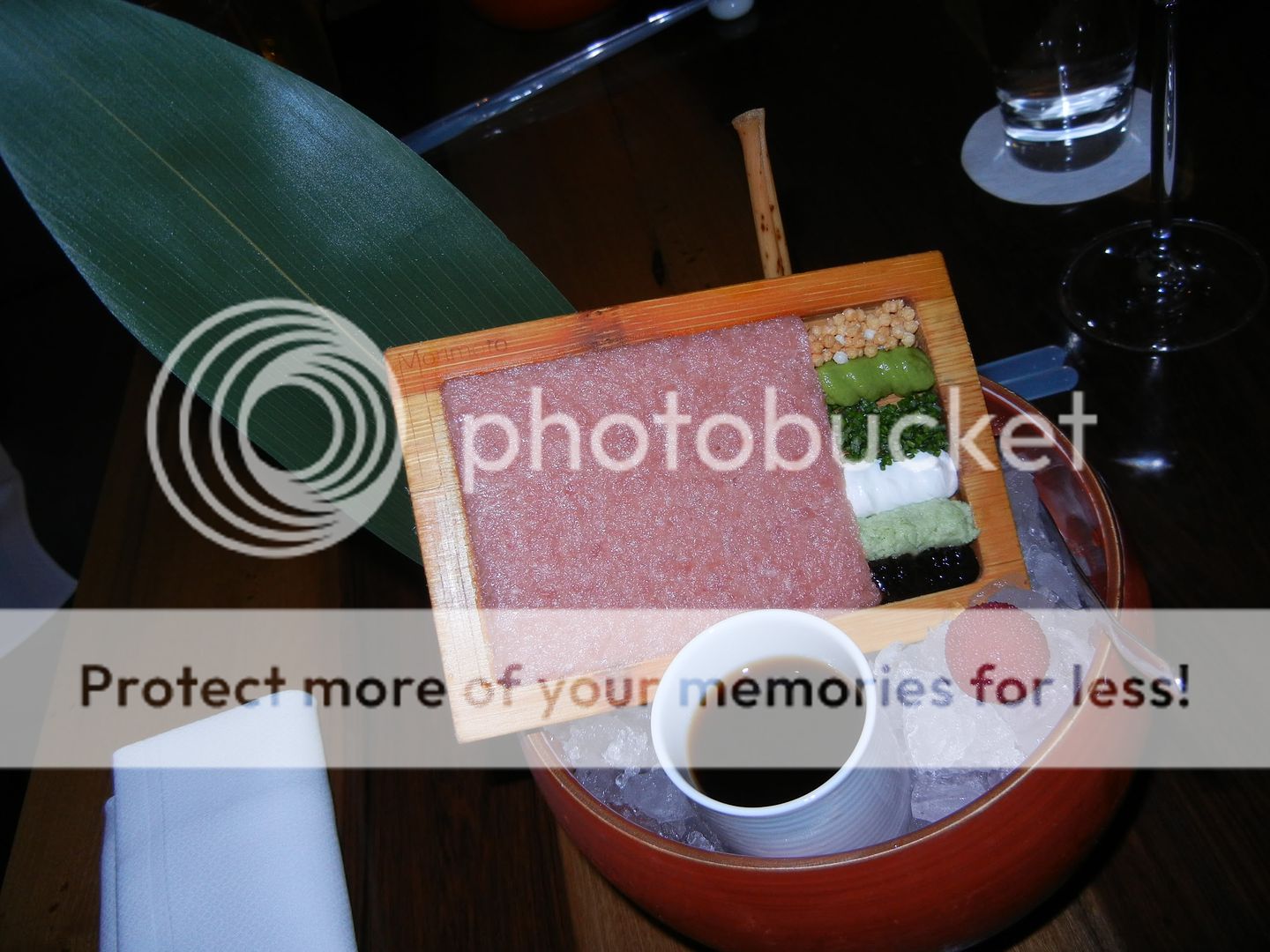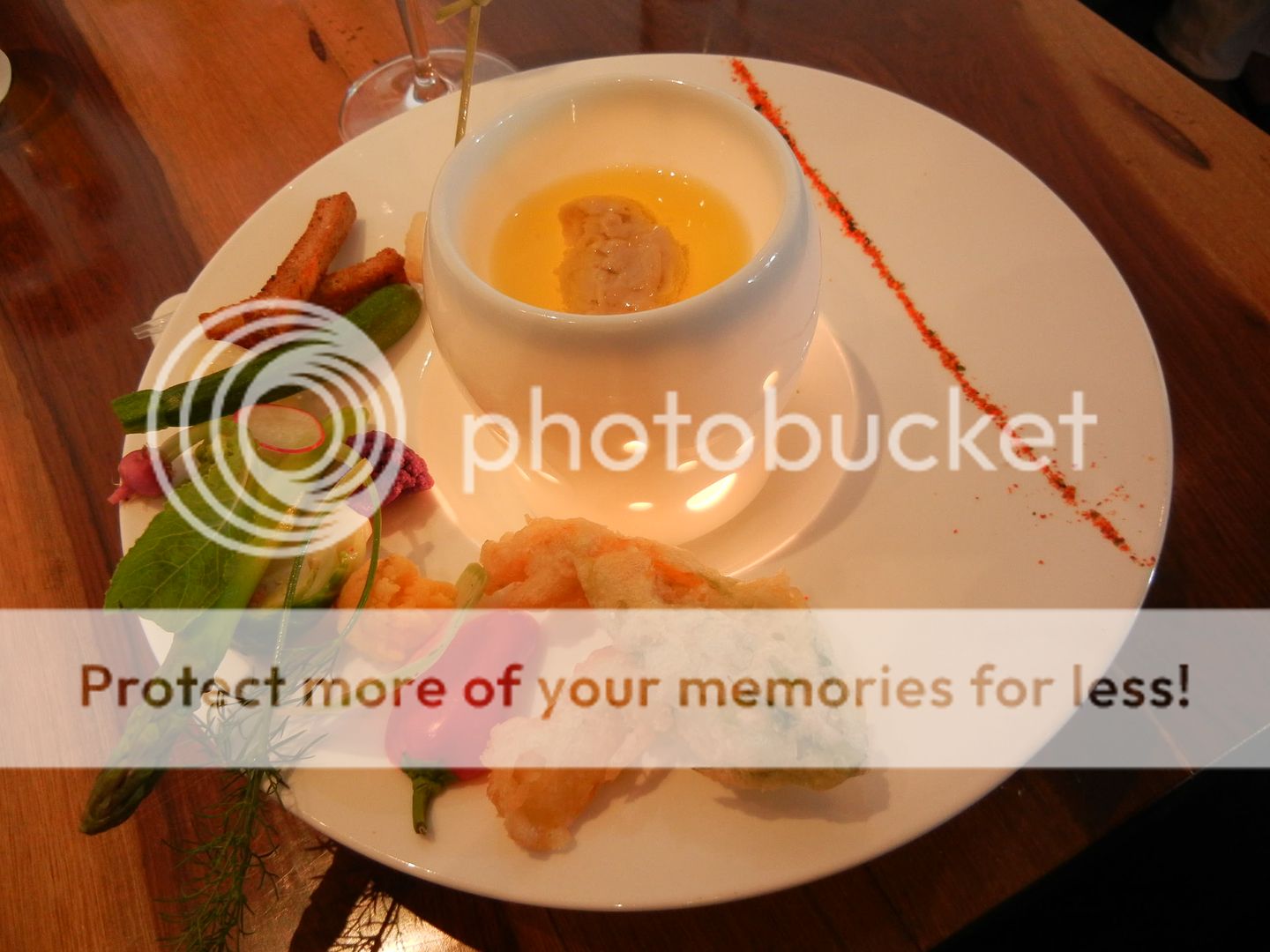A bit behind on blog postings of late due to overwhelming personal commitments but I wanted to get this review up before the memories escaped me. Last month Kathy treated me to a weekend in Napa to celebrate my 42nd birthday. The celebratory mood was slightly tarnished by the anniversary of the September 11th attacks (my personal thoughts here: 9/11 ) but despite that we had a wonderful weekend kicking around Napa Valley. We visited one of our favorite wineries in Napa, Grgich Cellars, took in the fantastic cellar tour at Schramsburgh (more on that in another post), and to thank Kathy for the weekend I bought her a couple of very nice one of a kind dresses from a local fashion designer.
On to the dinner at Morimoto; Masuharu Morimoto is among the best known of the Food Network’s “Celebrity Chefs". His extensive resume led him to stardom on the original Japanese “Iron Chef” TV show before the Food Network version. The most interesting element of his resume, to me, is that he spent some time as a professional baseball player in Japan as a catcher. Apparently a shoulder injury ended his athletic career, but as a baseball fan and foodie I found the information interesting.
The Morimoto Napa restaurant is located in the recently revitalized riverside district on Main St in Napa. It’s a stunningly beautiful space, dominated by polished concrete surfaces, decorated with a modest quantity of reclaimed wood building materials and wall sculpture crafted from desiccated grape vines. Generous glass walls on the river side of the building allow views of the river and lots of natural light. My only complaint about the space is that with all the hard, flat surfaces it is a bit loud. I’m more sensitive than most people due to hearing loss (eleven years in/around helicopters) but I found it challenging at times to hold a conversation comfortably with my wife. Not a lot they can do about it at this point, but I wish more interior architects/designers would keep acoustics in mind when designing high end restaurants.
For dinner we selected the Omakase tasting menu. Very reasonably priced at $110 per person it offered on this night eight courses featuring a few of Morimoto’s signature dishes and a number of unique to this Prix Fixe offering not found on the normal menu. The meal began with a Toro Tartare. This is one of his signature preparations and Morimoto frequently uses it or variations thereof on “Iron Chef” so having seen it so many times I was excited to try it. The Toro is hand chopped and served on a bamboo “platter” accompanied by a number of adjunctive “sides” including Wasabi, Nori Paste, Sour Cream, and lilliputian Rice Crackers that resembled uncooked cous-cous. I sincerely enjoyed this dish. The flavor of the Toro was amazing and I found that after trying each of the adjuncts I left them alone and just enjoyed the astonishingly fresh fish. I know that some folks enjoy the flavors of sushi/sashimi but are sometimes turned off by the texture of a mouthful of raw fish, if this is you, I highly recommend you try this dish. The preparation allows the diner to enjoy the flavor while selecting a portion that is pleasing without being overwhelming. The red ball seen below is a Japanese "Mountain Peach". I've never heard of such a thing before but it was awesome. I could have eaten a dozen of them.
The next dish was a hot oil seared Kanpachi Carpaccio. There is some confusion as to the name and to what it relates. If you see Kanpachi or Kampachi (with an “n” vs “m”) you are getting the same fish in terms of genus but the species is different and there is a difference in where the fish came from. Kanpachi is a Japanese Yellowtail Tuna that is wild caught while Kampachi is a Hawaiian Yellowtail Tuna that is usually farmed in open-ocean pens. The Japanese Kanpachi is generally leaner and smaller when sold. The farm raised Kampachi (most often a product of Kona Blue Water Farms) is a bit fattier and as such allows for a larger fish to be brought to market. Marine aquaculture aside let’s move on to the food. The grape sized rolls of flesh are “seared” in blazing-hot oil that is infused with garlic, chives and ginger. There is no malliard reaction (browning) associated with this because it’s an application of moist, not dry heat, rather the fish is just barely cooked in the oil while it’s interior remains largely raw though warm. I’ve no idea how they control this with such small, delicate bits of fish but it was exceptionally uniform. Each piece was cooked to the exact same level of “done” and the texture and flavor was astonishing.
The next dish was a Bagna Cauda served with a selection of fresh, seasonal vegetables. I was really surprised to see this very traditional Piedmontese (Northern Italy) preparation and it speaks to the depth and breadth of Morimoto’s culinary experience. A Bagna Cauda is a sort of an Italian Fondue of hot Olive Oil, Hazelnut or Walnut Oil that is seasoned with a paste of Garlic and Anchovy and in some cases marked with a bit of Cream. This particular offering used local Olive Oil, Garlic and Anchovy. It was beautiful on the plate, and allowed for an enjoyable “playing with your food” experience within the elevated “high-end dinning” environment.
The fourth dish of the evening was a unique twist on an exceptionally traditional Japanese preparation in a Foie Gras Chawanmushi. Chawanmushi literally means “steamed in a tea bowl” and is an egg based custard often flavored with Soy, Mirin and Dashi sauces and served with a variety of different earthy ingredients such as Mushrooms or root vegetables. In this case Foie Gras was the adjunct to the custard and a small slice of Duck Breast was floated atop the custard drifting in a pool of Mirin and Dashi. I’m a bit of a Foie and Duck junkie and as such I was very excited when the dish was brought to the table. My expectations were met and broadly exceeded. This thing was AMAZING. The creamy textures of the Custard and Foie were perfectly conjoined to the point where one couldn’t discern one from the other and the Duck Breast was among the most tender and flavorful I’ve ever had. The word “umami” has become popular of late and a photo of this dish should reside next to it in the dictionary. It is the very definition of the word.
An intermezzo of Watermelon & Wasabi Sorbet came next. It was bright, fresh tasting and perfect. I wish they’d brought one between each course.
The sixth offering of the evening was a plate of five Nigiri sushi. Not a great deal of surprise to be found here, but I will say that the fish was of exceptional quality. The Shari (rice) was thankfully, slightly warm. I loathe cold rice with my sushi and I’m always pleased when it it’s served warm to medium-hot. One particularly interesting feature was the chopped Jellyfish atop the Ahi which I have never seen before and very much enjoyed.
The penultimate dish was a “surf & turf” of Chutoro Wellington, Washyugu Flatiron Steak and Veal Tempura. I’ve never seen a Wellington of anything other than beef. I didn’t pick up a flavor of pate as in a traditional French "en-croute" preparation so I think the pastry was the only connection. Essentially it was a Toro & Unagi Makizushi in pastry and the Chutoro (Toro tuna belly) was only slightly warmed by the cooking and was quite delicious. The two bits of Washyugu (commonly called Wagyu) were cooked "en sous-vide" and then lightly seared. They were absolutely delightful. The deeply marbled beef had a creamy, almost Foie-like texture but with a very intense beef flavor that had an almost venison-like gamey finish. Awesome stuff. The final element of this dish was the Veal Tempura. I really enjoy veal….but I didn’t enjoy this at all. It was overcooked, under-seasoned and I had a single bite and let it be.
The desert course of the evening was quite a surprise. A Peach Spiced Churro served with a Mexican Hot Chocolate & Yuzu dipping sauce. A very playful spin on the early California Mexican influence on the region combined with some distinctly Asian flavors connecting two fascinating periods of California’s history in a single dish. This was by no means the Churro that you buy from a vendor at a Giants game. This was a Peach flavored cloud sprinkled with just a bit of cinnamon and sugar. I’m usually not one for desert after a big meal and I generally dislike churro’s but this was light enough to not overwhelm, playful, thought provoking and delicious.....the photo was lousy, sorry.
I mentioned earlier my complaint with the acoustics in the restaurant as a slight negative to the experience. The only other complaint I had was about the wine pairings with the meal. Each of the dishes was very enjoyable and each of the wines was as well. But I didn’t think that there was a compliment between the two. Perhaps, as Kathy opined, Japanese flavor profiles just don’t go that well with wine, or perhaps the choices weren’t well thought out but I felt that the additional expense to the meal was not a “value add”. Again, the wines were great, but the selections seemed slightly disconnected and not complimentary. I’d recommend you have a Sapporo instead with your meal and save the additional $80 to buy a bottle of something nice from a winery up the valley.
In total I deeply enjoyed the meal and save for the aforementioned concerns I’d unreservedly recommend Morimoto to you if you are heading to Napa.
Morimoto Napa
610 Main St.
Napa, CA 94559
707-252-1600
http://morimotonapa.com/











No comments:
Post a Comment